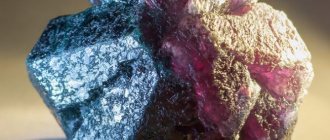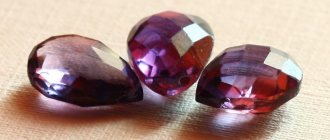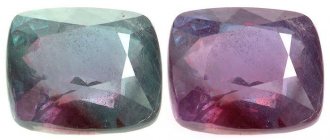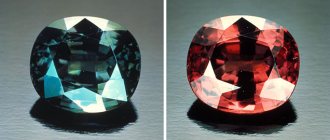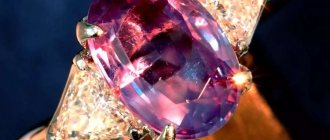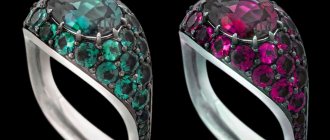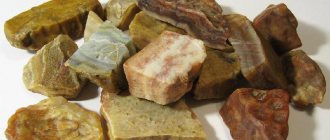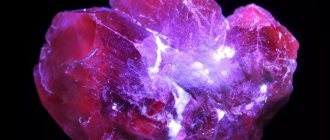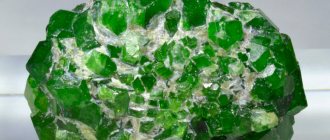Alexandrite is a gemstone that has healing and magical properties. It was discovered and mined in the 19th century in the Urals near Yekaterinburg.
The mineral was presented to the future ruler Alexander II on his coming of age. Since then it has been nicknamed alexandrite. Due to its amazing appearance, the stone immediately became extremely popular. Alexander II, who had already become king, tried not to part with this mineral. It became a talisman for him, which provided him with reliable protection.
There is an opinion that it was alexandrite that protected the life of the ruler during numerous assassination attempts. However, one day the king had the imprudence to forget to put on the stone. This became his fatal mistake. On that day, Alexander II was killed. This is just a version, but it is not without meaning. Since then, alexandrite has been considered a strong amulet.
However, during the wars, the meaning of the stone changed. The fact is that many women who had jewelry with this mineral were widowed. Then it received its other names: “stone of loneliness” and “widow’s stone.” Since that time, it has been believed that the stone cannot be worn in one copy; there must be a pair to go with it.
One way or another, people still believe in the magical properties of the stone and use it as a talisman.
History and origin
Alexandrite is rightfully considered a native Russian stone. The world's first specimen of the mineral was found in emerald mines near Yekaterinburg. This happened not so long ago, in the 30s of the 19th century, but now there are two versions of this event, which voice different dates of the discovery and different names of the discoverers.
According to one interpretation, the nugget was first found by Nils Nordenskiöld on April 17, 1834. The Finnish scientist did not have the opportunity to meticulously examine the strange find in the field, so at the first examination, the mineralogist decided that he had discovered an emerald crystal of not the highest degree of purity. This conclusion was based on the fact that the sample had a rich green color and low refractive indices.
After measuring the hardness of the stone, the confidence that it was an emerald was shaken. The instruments showed a value of 8.5 points on the Mohs scale, while for emerald this indicator should be a point lower. That same day, late in the evening, the scientist decided to examine the find by candlelight. Imagine Nordenskiöld's amazement when, instead of a green gem, he took a fiery red stone out of his pocket. The discovery of alexandrite occurred on the 16th birthday of Alexander II, the future Emperor of Russia, so the mineral was named in his honor.
Another version differs significantly from the first. Thus, alexandrite was discovered a year earlier, in 1833. The discovery was made by Ya. V. Kokovin. This happened in the emerald mines of the Tokovaya River, so the mineral was initially described as an emerald. The find was sent to St. Petersburg for detailed study.
There, Minister of Development L.A. Perovsky, assessing the increased hardness and pronounced pleochroism (change of color), concluded that it was not an emerald. At first they decided to call the find diaphanite, but later an opportunity arose to distinguish itself at court. Therefore, Perovsky presented the gem to the 16th anniversary of Alexander II, naming the stone after the future emperor.
This is interesting! In 1840, an alexandrite druse consisting of 22 crystals was discovered. The unique Ural find weighs almost 5.5 kg and is located in the Fersman Museum.
The Russian Empire, by chance, gave alexandrite many nicknames. First of all, the mineral became famous under the name “imperial stone”, as it became the personal amulet of Emperor Alexander II. It is known that during his life the Russian Tsar was able to escape the death prepared for him by his ill-wishers seven times. Only the eighth attempt became fatal for him. There is an opinion that Alexander’s life was preserved for many years by a ring with alexandrite. In addition, the nugget was green in daylight and red in evening light, which symbolized the two national colors of Russia.
Do you know that not only alexandrite can change its shade depending on the lighting. Green in daylight, and red in lamplight, can be a variety of garnet with chromium impurities, as well as polychroid green sapphire.
Almost immediately after the discovery of the gem, it became very popular among the Russian nobility. Moreover, people of exclusively noble origin who bore noble names could have alexandrite jewelry. The mineral became a heirloom. Even the richest merchants could not possess the desired jewel, since they had finances, but did not have a noble surname.
Thus, entering the 20th century, alexandrite became a fabulously expensive gem. By that time, all Russian nobility already possessed a sufficient amount of status jewelry. The outbreak of the First World War brought another glory to the mineral and another name – “widow’s stone”. The fact is that all Russian officers were of noble birth and the war took them all away in the first half of the year. Therefore, alexandrite became a symbol of women who did not receive their husbands from the battlefield.
A description of the stone in scientific literature appeared only in 1842. For a long time, the royal gem was considered an original Russian stone. Only at the end of the 20th century, other countries of the world began to find the mineral one by one - Brazil, South Africa, the islands of Sri Lanka and Madagascar.
Also read: Euclase is a rare mineral and a powerful talisman
Place of Birth
Russia is famous for its largest European deposit, the only one of its kind. Alexandrite is a rare mineral. Of the thousands of tons of processed rock at the Malyshevskoye deposit in the Urals, only 100 grams of alexandrite are mined daily. For comparison, the amount of mined emeralds is 15 times greater.
The island state of Sri Lanka is also considered a valuable supplier of the mineral. Brazilians today find only rare individual specimens of the gem, since their only deposit was mined in just 3 months back in 1987.
Along with sapphires and rubies, alexandrites are mined on the island of Madagascar and Tanzania. However, the color changes of African stones are less contrasting.
Where is Alexandrite mined?
In addition to Russia, the mineral alexandrite is also mined abroad. In particular, in the following states:
- India;
- Brazil;
- Burma;
- Sri Lanka;
- Zimbabwe;
- Tanzania.
Chameleon stone is not mined in all countries of the world.
Alexandrite of natural origin is very rare. This is what influenced its price. Not everyone can afford jewelry with such a stone. However, in the territories of the above countries, the highest quality gemstone is mined.
The largest sample found in Russia was 535 carats (translated into a weight that is more understandable to us - about 107 grams). Among the foreign nuggets, a specimen of 1870 carats (equal to 374 grams) was discovered.
Physical properties
Alexandrite is one of the varieties of chrysoberyl. Chromium impurities, as well as the structural features of the mineral’s crystal lattice, give the stone pronounced pleochroism.
| Property | Description |
| Formula | Al2BeO4 |
| Impurity | Cr |
| Hardness | 8,5 |
| Density | 3.5–3.84 g/cm³ |
| Refractive index | 1,744–1,758 |
| singonia | Rhombic. |
| Kink | Conchoidal. |
| Cleavage | Imperfect. |
| Shine | Glass. |
| Transparency | Transparent or translucent. |
| Color | In daylight: dark blue-green, bluish green, dark grass green, olive green; In evening or artificial light: pink-crimson, red-violet, purple. |
This "Alexandrite effect" allows the gem to appear blue-green, olive green or grassy in sunlight and crimson, violet-red or purple in dim evening light. Some gem samples are endowed with opalescence - a cat's eye effect.
What types of alexandrite are there?
There are several varieties of alexandrite, all of which depend on its location.
- “Ural” is considered the rarest and, accordingly, the best. It is the brightest and purest. Daylight gives the mineral an emerald-greenish hue, while artificial light gives it a reddish-violet hue.
- “Indian” - daylight gives a charming greenish-blue color.
- “Brazilian” is less bright than Ural; in natural light it takes on a marsh-green color.
- “Sri Lankan” - under artificially created light it acquires a brownish tint.
Colors and varieties
Alexandrite belongs to minerals without a clear classification of varieties. All stones are characterized by a change in color when lighting changes from natural to artificial. The phenomenon of pleochroism in the language of jewelers is called color reverse.
Alexandrite is the same chameleon. During the day, the stone casts all shades of green, sometimes with an admixture of blue. In the evening, the stone is rich in other colors - from pink to dark red. There are examples of evening scarlet or lilac. And under some types of lamps, alexandrite can turn yellow.
If we compare nuggets by place of extraction, then Russian gems are certainly brighter than Brazilian or African ones. But Ceylon specimens, originally from Sri Lanka, compete with Ural gems in the presence of unusual effects, for example, opalescence.
Description
Scientists explain the variable color of the stone by the original structure of its crystal lattice. Very rarely, but colorless alexandrites are still found. Most often they have a green-blue tint. The minerals are always transparent with a beautiful glassy sheen and are small in size.
The Ural gems are considered the most beautiful. Indian and Brazilian stones are widely known. Gems from Sri Lanka are inferior to them in brightness, but among them there are interesting specimens of a brown hue.
Interesting on the topic! Lapis lazuli stone: a talisman of sincerity and decency
Natural alexandrite is a rare mineral; it is one of the five most expensive stones in the world. The precious stone is most often set in gold.
Medicinal properties
One of the French esotericists drew a parallel between two shades of alexandrite and similar colors of human blood - venous and arterial. This is how the direct effect of natural gemstone on the human circulatory system was discovered:
- improvement of blood composition;
- help with varicose veins;
- cleansing and strengthening blood vessels;
- positive effect on heart rate and blood pressure;
- prevention of blood clots.
Lithotherapists note a therapeutic effect for diseases of the liver, spleen, gastrointestinal tract, as well as in the case of nervous system disorders - depression, insomnia, apathy, and the like.
Alexandrite will be useful for people who want to get rid of alcohol addiction. Water infused with alexandrite overnight will help you get rid of your bad habit. In addition, the gem is a general preventive remedy, provided that the stone is natural.
Magic force
The Imperial Stone is a talisman of strong, strong-willed individuals. A person of weak spirit is not recommended to wear such an amulet, because not everyone can withstand the tests sent by the mineral. To those who can, the nugget will bestow support and gifts of fate at the finish line of all obstacles.
The magical abilities of the mineral are ambiguous, as are its names. Alexandrite is a prophet and communicator with other worlds. Therefore, the mineral is used during meditation for the purpose of astral travel.
But only evil can prophesy a stone. Alexandrite will definitely warn the owner of the danger, changing its green tint during the day to the scarlet color typical of the evening. It is believed that the nugget thereby warns the owner of injuries or illnesses associated with bleeding. In a life-threatening situation, the mineral turns yellow.
On the other hand, alexandrite is considered a stone of good fortune and luck, which makes it the best friend of adventurers, regardless of the type of activity. Therefore, sailors, military personnel, businessmen, lawyers and, of course, players simply need to have such a talisman. The gem is suitable for people of art - the stone will give them inspiration, and will also reveal the talents of those in whom they have been sleeping until now.
Also read: Cat's eye - magical light inside the crystal
But those whose life is a quiet haven do not need alexandrite. The mineral will disrupt the calm of a quiet life, introducing into it a storm of passions, risk and danger. For girls, the gem will become a source of attractiveness and the key to success in love.
Compatibility with other stones
The Imperial Nugget is a Water stone. The mineral, unique in everything, showed a special uniqueness here too - friendliness towards Fire. However, not all fire gems can become friends of alexandrite, but only stones of equal rank and luxury - Rubies and Diamonds. But Heliodor, Garnet and Grossular do not go together. Air minerals are also not a match for him. Among them:
- Amethyst;
- Rhinestone;
- Demantoid;
- Uvarovite;
- Smoky and rose quartz;
- Amazonite;
- Topaz.
Alexandrite will tolerate representatives of the Earth next to it, but only of the highest degree of value, such as:
- Turquoise;
- Jade;
- Chalcedony;
- Onyx;
- Jasper.
It is better not to use jet and cacholong with Alexandrite in the same jewelry.
And, of course, the most successful combination is native water minerals:
- Pearl;
- Opal, including the black variety;
- Sapphire;
- Moon rock.
Alexandrite is most closely related to emerald.
Jewelry with mineral
Alexandrite is a first-order mineral, that is, the most expensive. Fellow “caste” stones are rubies, diamonds, emeralds and sapphires. The price of one carat of the purest alexandrite can reach 1 million US dollars. Individual pieces are valued at more than similar diamonds.
Today, jewelers offer jewelry with natural or artificial stone. It is worth noting that an artificial mineral is inferior to a natural one only in price, but in properties, appearance and degree of pleochroism it sometimes surpasses a natural gem. Naturally, the synthetic analogue has neither magical nor healing abilities.
So, pure, flawless alexandrite can most likely be found only in private collections, or you can order custom-made jewelry. Both will cost exorbitant amounts of money. On the shelves of jewelry stores you can find either artificial minerals or natural ones, but of lower quality (insignificant reverse indicator, turbidity). The prices of both options are comparable.
Jewelry with natural alexandrite is made from gold or platinum. In addition to these metals, synthetic stones are also set in silver. Starting price for a product with an artificial gem:
- Earrings made of gold - from 30 thousand rubles.
- Ring – from 20 thousand.
Silver products are cheaper. But products with natural stone of the highest category are purchased at auctions for millions of dollars.
Read more about jewelry with Alexandrite: Read the article
What is the price
The lack of geological developments and the uniqueness of the palette make alexandrite more expensive than rubies and sapphires. Ural nuggets cost from 20 to 30 thousand US dollars per 1 carat, the size of which rarely exceeds the specimens mined in the 19th century. Antique jewelry is sold on the black market for 50-100 thousand in US currency.
Synthetic corundums are estimated at $250 - $500 for the same weight, depending on the purity of the color transition. The average cost of earrings framed in gold is $350-400. Silver does not go well with the proud royal gem; opponents of the yellow metal are better off choosing platinum.
How to distinguish natural stone from fake
Natural gem is replaced with three different options:
- synthetically grown crystal;
- refined natural stones of the lowest category;
- glass stones.
Only glass is considered fake. Artificial alexandrite or a garnet passed off as it, for example, is an imitation, but not a fake, since it is similar in characteristics or refers to a natural mineral.
The first and only reason to assume that this is a fake is the lack of a certificate certifying the authenticity of the stone. If there is no document, then the stone is fake. Another thing is to check the authenticity of the document itself, if available, by contacting the service that issues these certificates.
If there is no document or it is not real, it will be interesting what exactly the buyer is offering. It is difficult to determine the origin of a stone on your own, but you can try this way:
- A glass fake is the easiest to recognize, since there will be no pleochroism, and instead, in the light the stone will shimmer with all the colors of the rainbow. In addition, such a “gem” is easy to scratch with a regular needle.
- In the case of refined tourmalines, garnets or pyrope, it is more difficult; you can distinguish each of them by knowing all the signs of a natural stone. Typically, such imitations reveal themselves by atypical shades, highlights, and refraction of light.
- A synthetically grown crystal is distinguished by its size larger than 1 carat, crystal transparency and the shape of the internal bubbles (for a natural stone it is a drop, while for an analogue it is a sphere).
If you want alexandrite just for decoration, a synthetic crystal is a good option. You can only find protection and patronage with natural stone.
Pendant with Alexandrite
Who is alexandrite not suitable for?
The gem prefers those who are confident, brave or those who strive to become such, so people with a weak position of Mars in Pisces, Libra and Taurus and Saturn in Capricorn in the natal chart should not wear it. It will only aggravate psychological difficulties, especially with the accompanying negative aspects with Mercury, Pluto and the square between Mars and Saturn.
The explosive energy of the amulet of rulers and political leaders is not suitable for modest and shy Cancers, Pisces and Virgos, who are sensitive to leaving their comfort zone. If there is a strong position of the ruling planets in the horoscope, an alliance with a stone is permissible.
How to wear it correctly
Since alexandrite is an assistant in new and risky matters, it is recommended to purchase it on the first Monday of the new lunar cycle, during the “young month”.
Also read: Pyrope or Bohemian ruby - a stone for a happy family
If we are talking about a natural stone, then, according to beliefs, it is a purely masculine mineral that brings misfortune to women. This is especially true for married ladies. However, for the fairer sex there is a way to ward off trouble - wear two jewelry at the same time or combine alexandrite with diamonds. Despite all the superstitiousness, the range of men's jewelry is very meager.
This is interesting! When Alexander II died, a new fashion began for alexandrite jewelry. Thus, the gem in the product was supposed to be complemented by two diamonds, as a symbol of two historically important reforms of the emperor - the abolition of serfdom and judicial reform. In addition, the number 2 was the king's serial number.
Jewelry with alexandrite of any origin is an attribute of mature women. You can wear them to complement your office style or to special evening events, there is no third option. Discreet silver accessories are suitable for the office, and gold items are suitable for social parties, complete with a luxurious outfit.
Favorable time to buy
It is easier to feel contact with the future amulet on days 15-16 of the lunar cycle, when the energies of the full moon bubble, turning off the mind and awakening the wisdom of the subconscious. The two-faced magic of the stone will feel bursts of contradictory moods and will manifest itself through the harmonization of psychological imbalance, a surge of inspiration and optimism.
By trying on the jewelry and being in mental contact with it, the future owner will quickly feel the warmth of an emotional connection during the reign of the Moon. Gemologists advise making a purchase just before sunset to assess the color transition from daytime to evening colors.
Name compatibility
A strong stone is a reliable patron of a strong name. Alexandrite – suitable for names:
- Alexandra. Alexandra's unbalanced character and frequent mood swings need to be pacified. The gem will calm, balance in moments of temper and cheer up when despondency overtakes.
- Alexander. The stone affects the owner’s emotional background in the same way as it does Alexandra. In addition, the talisman will attract good luck, financial well-being to the owner, and will help to be open in relationships. The nugget will protect against stress, and in case of danger to physical or psychological health, it will change color.
- Lyudmila. She is characterized by excessive emotionality, which often leads to the wrong hasty actions. The amulet will calm the storm of emotions, removing obstacles in Lyudmila’s life path. And the change in color of the mineral will warn her of dangers.
Alexandrite is suitable for anyone who feels the strength to withstand its energy. Zodiac affiliation plays a significant role.
Astrological compatibility
Not all signs of the zodiac circle can wear alexandrite talismans. The gem is best suited:
(“+++” – the stone fits perfectly, “+” – can be worn, “-” – is strictly contraindicated):
| Zodiac sign | Compatibility |
| Aries | + |
| Taurus | — |
| Twins | +++ |
| Cancer | — |
| a lion | +++ |
| Virgo | — |
| Scales | + |
| Scorpion | +++ |
| Sagittarius | + |
| Capricorn | + |
| Aquarius | +++ |
| Fish | + |
- Aquarius. The mineral will greatly enhance the intuition and creativity of this sign.
- Leos. The royal gem is perfectly suited to the royal constellation, attracting success and power.
- Gemini. Alexandrite will pacify the inconstancy and craving of Gemini in different directions on the path of life, giving internal balance.
- Scorpios. Fighters by nature, they need a talisman that supports their spiritual aspirations to overcome all obstacles.
- For Aries, the stone will give protection and good luck in any endeavor.
- Sagittarians need self-confidence.
- Pisces. Luck will follow you through life.
- For Capricorns, the stone will help improve their financial situation, as well as strengthen their intuitive thinking.
- For Libra, the mineral will help reveal creative inclinations and give good luck in business.
And only Virgos, Taurus and Cancers do not recommend wearing a gem, since the character traits of these signs are not able to withstand the tests prepared by the gem.
Astrologers also recommend, first of all, focusing on internal sensations when in contact with alexandrite. It happens that a mineral is suitable for all parameters and compatibility, but in fact causes internal discomfort. Then it is better to refuse it, choosing another talisman for yourself.
Perfect fit
Who is the Alexandrite stone best suited for its properties according to the zodiac sign - Gemini, Leo, Pisces.
Twins
The ability of this mineral to change color and its clearly dual nature directly indicates compatibility with Gemini, who is also fickle.
Often representatives of this sign are restless and can often make wrong decisions due to excessive emotionality. And here is Alexandrite:
- will give them the necessary peace of mind;
- will help you understand yourself;
- will help you make the right decisions.
All this will have a beneficial effect on the life of Gemini.
a lion
Since the discovery of this mineral, it has always been associated with the royal family and was considered the stone of Lions, because they are known to be the kings of the animal world.
If a representative under the zodiac sign Leo acquires Alexandrite, then it will bring him a lot of benefits, primarily in his career.
But besides this, you should count on:
- will contribute to success in any endeavor;
- improve relationships with others;
- will smooth out character flaws.
Fish
Another zodiac sign for whom Alexandrite is suitable is Pisces. You should definitely wear it if you have any difficulties at work or business. In this case, even the most difficult situation can be resolved in a positive way.
And also for a man or woman, Pisces will develop not only intuition, but logical thinking, which will immediately affect the learning process. For this reason, if someone close to you or you yourself are persistently studying something, then it would be reasonable to purchase this mineral as an assistant.
Note
Alexandrite contains an inner strength that can attract difficulties and at the same time resist them. Due to its rarity and high cost, not everyone can afford to feel the support of this unusual mineral. Those who have such an honor are very lucky, because having a persistent character and strong will, you can enlist the support of the imperial nugget from the Urals.
Photo gallery of stone
5/5 — (1 vote)
What you need to know when purchasing alexandrite
The natural processed mineral is small in size. On sale there are stones of 2-3 carats. All large stones over 5 carats are included in the catalogue. Each natural alexandrite has an original certificate, which is an act of gemological examination.
If you do not have such a document, you should know that you are buying an artificial (fake) alexandrite stone. You can check the authenticity of the act itself by contacting the representative of the organization that issued it. Information about the authenticity of the certificate can also be found on the official website of the expert organization.
Natural alexandrites were used to decorate jewelry made in Tsarist Russia. In Soviet times, jewelry was made only using artificial stones and analogues of alexandrites - garnet, rubies, spinel. These are also natural gems, but their cost is much lower than the price of natural alexandrite.
This is interesting ! The largest specimen of Russian alexandrite weighs 30 carats.
